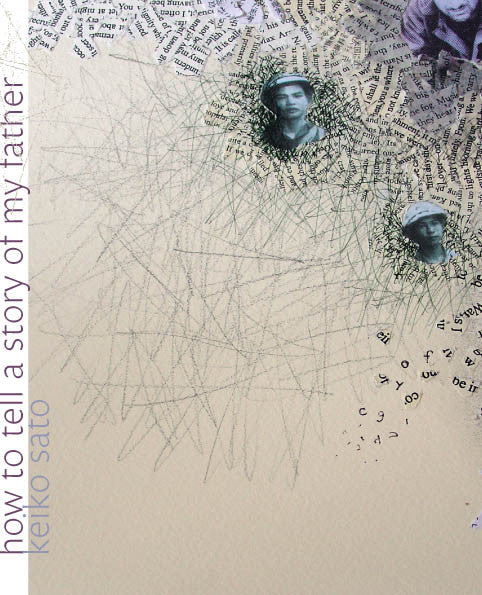Your cart is currently empty!
How to tell a story of my father
+++ +++
+++Keiko Sato+++
978-94-90322-03-8
Montse Hernández i Sala
124
17 x 21
Paperback
Engelstalig
Deze publicatie is mede mogelijk gemaakt door het Fonds BKVB.
Verschijningsdatum: november 2009
Op 11 september 2001 was beeldend kunstenaar Keiko Sato in New York toen de Verenigde Staten getroffen werden door de terroristische aanslagen op de Twin Towers. De zelfmoordcommando's die met hun vliegtuigen de wolkenkrabbers binnenvlogen, en uiteindelijk deze iconen van de Westerse wereld volledig ten onder lieten gaan, herinnerden Sato aan haar eigen vader, die als Japanse kamikaze piloot de Tweede Wereldoorlog overleefde.
How to tell a story of my father is een bijzonder document met teksten, interviews en kunstbijdragen van Keiko Sato. Het project probeert de sporen bloot te leggen van de invloed die een oorlog heeft op een samenleving, een individu, de herinnering, en op volgende generaties.
Keiko Sato werd in 1957 geboren in Iwaki-stad in Japan. Van 1979 tot 1989 was zij werkzaam als vroedvrouw. In 1989 gooide Sato het roer om, en ging beeldende kunst studeren aan het Goldsmiths College in Londen, waarna zij haar studie vervolgde met een opleiding beeldende kunsten aan de Jan Van Eyck Academie in Maastricht, waar zij in 1995 afstudeerde. Sato woont en werkt momenteel in Nijmegen.
Een fragment uit How to tell a story of my father
'The people who were involved in the incident would never forget what happened to them. Their memories would remain in their mind, and these would eventually be passed on to their children. History is not only the accumulation of chronological events, but also the collective memory of people. We live now, but our present life is connected with the past, and so is our history. Forgotten memories could suddenly come back to our mind. The terrorist attack and kamikaze acts are very different matters. However, what I experienced in New York led me to the memories of my father, although I hardly remember him. It was by sheer chance that I was not born in the time and place where a war was going on. I have not encountered a politically complex and life-threatening situation before. Yet, this may purely be a coincidence or luck. A question then came to my mind: If I were a soldier in the war, must I kill my enemy? 'Yes, I have to. Otherwise, I would be killed. Or I could be tortured and murdered even if I was just a civilian.' That I could be a perpetrator as well as a victim is a frightening thought. I realized that it depends on the circumstances and my personal situation.' - Keiko Sato
€24.95
How to tell a story of my father
€24.95
978-94-90322-03-8
Montse Hernández i Sala
124
17 x 21
Paperback
Engelstalig
Deze publicatie is mede mogelijk gemaakt door het Fonds BKVB.
Verschijningsdatum: november 2009
Op 11 september 2001 was beeldend kunstenaar Keiko Sato in New York toen de Verenigde Staten getroffen werden door de terroristische aanslagen op de Twin Towers. De zelfmoordcommando's die met hun vliegtuigen de wolkenkrabbers binnenvlogen, en uiteindelijk deze iconen van de Westerse wereld volledig ten onder lieten gaan, herinnerden Sato aan haar eigen vader, die als Japanse kamikaze piloot de Tweede Wereldoorlog overleefde.
How to tell a story of my father is een bijzonder document met teksten, interviews en kunstbijdragen van Keiko Sato. Het project probeert de sporen bloot te leggen van de invloed die een oorlog heeft op een samenleving, een individu, de herinnering, en op volgende generaties.
Keiko Sato werd in 1957 geboren in Iwaki-stad in Japan. Van 1979 tot 1989 was zij werkzaam als vroedvrouw. In 1989 gooide Sato het roer om, en ging beeldende kunst studeren aan het Goldsmiths College in Londen, waarna zij haar studie vervolgde met een opleiding beeldende kunsten aan de Jan Van Eyck Academie in Maastricht, waar zij in 1995 afstudeerde. Sato woont en werkt momenteel in Nijmegen.
Een fragment uit How to tell a story of my father
'The people who were involved in the incident would never forget what happened to them. Their memories would remain in their mind, and these would eventually be passed on to their children. History is not only the accumulation of chronological events, but also the collective memory of people. We live now, but our present life is connected with the past, and so is our history. Forgotten memories could suddenly come back to our mind. The terrorist attack and kamikaze acts are very different matters. However, what I experienced in New York led me to the memories of my father, although I hardly remember him. It was by sheer chance that I was not born in the time and place where a war was going on. I have not encountered a politically complex and life-threatening situation before. Yet, this may purely be a coincidence or luck. A question then came to my mind: If I were a soldier in the war, must I kill my enemy? 'Yes, I have to. Otherwise, I would be killed. Or I could be tortured and murdered even if I was just a civilian.' That I could be a perpetrator as well as a victim is a frightening thought. I realized that it depends on the circumstances and my personal situation.' - Keiko Sato



